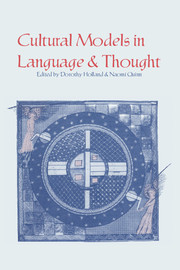Book contents
- Frontmatter
- Contents
- Preface
- List of Contributors
- Introduction
- Part I Presupposed worlds, language, and discourse
- Part II Reasoning and problem solving from presupposed worlds
- Part III The role of metaphor and analogy in representing knowledge of presupposed worlds
- 8 The cognitive model of anger inherent in American English
- 9 Two theories of home heat control
- 10 How people construct mental models
- Part IV Negotiating social and psychological realities
- Part V An appraisal
- Index
9 - Two theories of home heat control
Published online by Cambridge University Press: 05 June 2012
- Frontmatter
- Contents
- Preface
- List of Contributors
- Introduction
- Part I Presupposed worlds, language, and discourse
- Part II Reasoning and problem solving from presupposed worlds
- Part III The role of metaphor and analogy in representing knowledge of presupposed worlds
- 8 The cognitive model of anger inherent in American English
- 9 Two theories of home heat control
- 10 How people construct mental models
- Part IV Negotiating social and psychological realities
- Part V An appraisal
- Index
Summary
Human beings strive to connect related phenomena and make sense of the world. In so doing, they create what I call folk theory. The word folk signifies both that these theories are shared by a social group and that they are acquired from everyday experience or social interaction. To call them theories is to assert that they use abstractions that apply to many analogous situations, enable predictions, and guide behavior. I contrast folk theories with institutionalized theories, which are used by specialists and acquired from scientific literature or controlled experiments. Thus, a folk theory is one type of cultural model.
This chapter analyzes folk theories for home heating control, particularly thermostat control. From interviews with Michigan residents, folk theories were inferred using methods developed by Lakoff and Johnson (1980; also see Lakoff & Kövecses this volume) and Quinn (1982; this volume). The inferred folk theories were compared with behavior guided by the theory, using both observed behavior and self-reported behavior. The interviews also elicited lists of devices analogous to thermostats and a history of use in present and past residences.
The concept of folk theory
Anthropological interest in folk theory has germinated over the past few years in the form of two recent volumes (Dougherty 1985; Marsella & White 1982) and the conference leading to the present volume.
- Type
- Chapter
- Information
- Cultural Models in Language and Thought , pp. 222 - 242Publisher: Cambridge University PressPrint publication year: 1987
- 38
- Cited by



